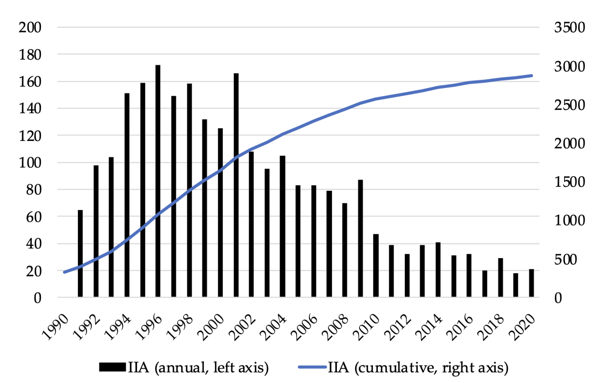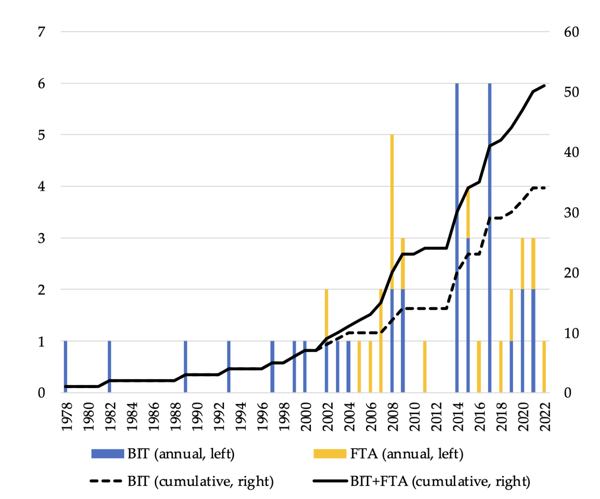The number of international investment agreements signed by Japan has increased since the 1990s, in contrast to world trends. This column analyses the impact of these agreements on foreign direct investment by Japanese firms. Using data on 12,455 Japanese cases of FDI in 94 countries over the period 1990-2019, it shows that enacting an international investment agreement with Japan significantly increases the likelihood of being selected as an FDI destination. Host countries are encouraged to sign such agreements, as FDI flows can contribute greatly to economic development and growth.
In the mid-1990s, the rate of increase in the number of international investment agreements (IIAs), which are aimed at promoting foreign direct investment (FDI), began to decline, and the interest has continued to decline in the 2010s around the world (Figure 1). One reason is simply the decrease in the remaining number of countries with which IIAs are possible with every IIA signed. Another reason is the growing concern by FDI host governments about the reduction in their policy space resulting from IIAs, as IIAs tie the host government’s hands in formulating and implementing policies. IIAs make it difficult for the host government to restrict FDI with the objective of developing industries of their interest. Yet another reason is mixed research results on the effectiveness of IIAs in terms of attracting FDI, which would contribute to economic growth of the host country. Contrary to the global trend, the number of IIAs signed by Japan continued to increase in recent decades (Figure 2). In light of contrasting developments between the world and Japan regarding IIAs, in Urata and Baek (2022) we examined the impacts of IIAs on FDI in the case of Japan.


Rigorous empirical studies of the impact of IIAs on FDI, including bilateral investment treaties (BITs) and free trade agreements (FTAs) with an investment chapter, began to be undertaken in the 2000s. Their main results can be summarised as follows. First, the impacts of BITs on FDI are mixed, in that some studies found positive impacts (Aisbett et al. 2018, Frenkel and Walter 2019), while some studies did not find significantly positive impacts (Hallward-Driemeier 2003, Tobin and Rose-Ackerman 2005). Second, high quality BITs, that is BITs with low flexibility given to the host government in terms of influencing the behaviour of foreign investors, are shown to promote FDI (Dixon and Haslam 2016). Third, mixed results are obtained regarding the relationship between BITs and the institutional quality of the host government. Some studies found complementary relationships, meaning that BITs are effective in attracting FDI in the countries with high institutional quality (Hallward-Driemeier 2003, Tobin and Rose-Ackerman 2005), while some found substitutability relationships (Busse et al. 2010, Neumayer and Spess 2005). In our study, we considered both the quality of IIAs and the institutional quality of host governments. We broadened the scope of institutional quality of the host government by taking account of the past record of involvement in disputes.
We analysed 42 Japanese IIAs that entered into force from 1978 to 2018, of which 29 were BITs and 13 were FTAs. An IIA can be classified into two types regarding FDI: protection and liberalisation types. Most IIAs that entered into force in the 20th century were of the protection type, while the liberalisation type has become the mainstream in the 21st century.
We conducted an empirical analysis to discern the characteristics of countries selected as FDI destinations by Japanese firms by applying the conditional logit model. The data covers 12,445 Japanese FDI cases in 94 countries for the 2000–2019 period. Both dependent and explanatory variables in the regression analysis are those related to potential FDI host countries. The dependent variable is a dichotomous variable equal to one for the presence of FDI and zero otherwise. The explanatory variables are country-specific characteristics, which include not only the key variables such as the presence of an IIA, IIA quality, past record of involvement in disputes, and the institutional quality of the host country, but also standard variables used in the earlier studies on the locational determinants of FDI such as market size, wages, economic growth rate, geographical distance, and the extent of agglomeration by Japanese firms. Concerning the quality of IIAs, a high-quality IIA refers to an IIA with provisions on pre-establishment national treatment, prohibition of performance requirements, use of the negative list approach for reserved sectors, expropriation and compensation, and investor-state dispute settlement.
Our major findings are as follows. First, enacting an IIA with Japan increases the probability of being selected as an FDI destination by Japanese firms by 74% for all firms and 151% for small and medium-sized enterprises (SMEs). In addition, comprehensive and high-level IIAs have greater positive effects on Japan’s FDI. Second, high regulatory quality of the host country is found to increase the probability of being chosen as an FDI destination for Japanese FDI. Third, the positive impact of IIAs in attracting FDI is strong even in countries with low regulatory quality, indicating substitutability between IIAs and regulatory quality. This result does not mean that the regulatory quality is not important. It means that the degree of the effectiveness of IIAs in increasing the probability of attracting FDI declines as the level of regulatory quality in the host country rises. Fourth, the past incidence of investor-state disputes is shown to have a negative impact. Fifth, the impacts of IIAs, their quality, and past involvement in disputes are greater for SMEs than for large firms. These findings seem to reflect that SMEs with limited human and financial resources cannot deal with possible risks, such as unexpected changes in government policy, and therefore, SMEs rely more heavily on international rules and agreements compared with large firms. Finally, FDI in manufacturing is found to be more sensitive in terms of IIAs, their quality, and past involvement in disputes compared with FDI in services. Considering that the magnitude of FDI in manufacturing is on average larger compared to services, this finding indicates that a firm undertaking large FDI is more sensitive to IIAs because of high sunk costs.
Several policy recommendations may be drawn from the results of the analysis. First, governments are advised to establish IIAs. For the home country’s government, IIAs can provide their firms with a business-friendly environment with clearly defined rules and regulations. For the host country’s government, IIAs can attract FDI, which would contribute greatly to economic development/growth. Second, the host country’s government needs to negotiate carefully and thoroughly to conclude an IIA that does not cause disputes after the IIA enters into force. Third, the host government needs to improve the quality of institutions, such as the government and regulatory system, to increase its attractiveness to foreign investors. To achieve this goal, governments may need to implement policy reform, such as regulatory reform.
Author’s note: The main research on which this column is based (Urata and Baek 2022) first appeared as a Discussion Paper of the Research Institute of Economy, Trade and Industry (RIETI) of Japan.This article first appeared on VoxEU on October 21, 2022. Reproduced with permission.



